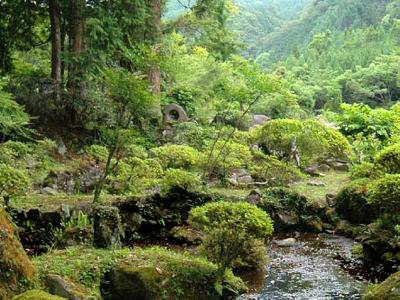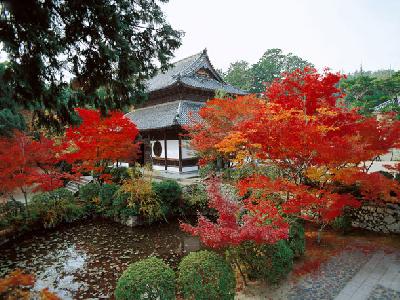|
The Sesshu Garden at Sho'okuji Temple in Sao, Hiji, Hayami County, Oita Prefecture, was reputedly built by the famous Zen monk and artist Sesshu.
Sho'okuji Temple belonged to the Kinoshita family, who were the Hiji domain heads. This family continued for 16 generations and there are more than 40 gravestones at the temple, including that of Asahi-no-kata, mother of Kita-no-Mandokoro.
The temple garden includes the Manryu Garden, which Sesshu is also reputed to have built, and which contains the largest cycad in Japan, designated as a national natural treasure.
After his return from Ming China in the first year of the Bunmei period (1469), Sesshu set up his studio somewhere around Oita. He later moved to Yamaguchi, then Shimane, and so on. His fame has never diminished and even today, he continues to be admired as a god of painting.
Sesshu Garden features a nearby mountain as a 'borrowed landscape' and has a pond shaped like the Chinese character '心' for 'heart'. Sesshu's artistry and sensibility continue to astonish us today.
Sho'okuji Temple belonged to the Kinoshita family, who were the Hiji domain heads. This family continued for 16 generations and there are more than 40 gravestones at the temple, including that of Asahi-no-kata, mother of Kita-no-Mandokoro.
The temple garden includes the Manryu Garden, which Sesshu is also reputed to have built, and which contains the largest cycad in Japan, designated as a national natural treasure.
After his return from Ming China in the first year of the Bunmei period (1469), Sesshu set up his studio somewhere around Oita. He later moved to Yamaguchi, then Shimane, and so on. His fame has never diminished and even today, he continues to be admired as a god of painting.
Sesshu Garden features a nearby mountain as a 'borrowed landscape' and has a pond shaped like the Chinese character '心' for 'heart'. Sesshu's artistry and sensibility continue to astonish us today.
| [+ADDRESS] | 
|













